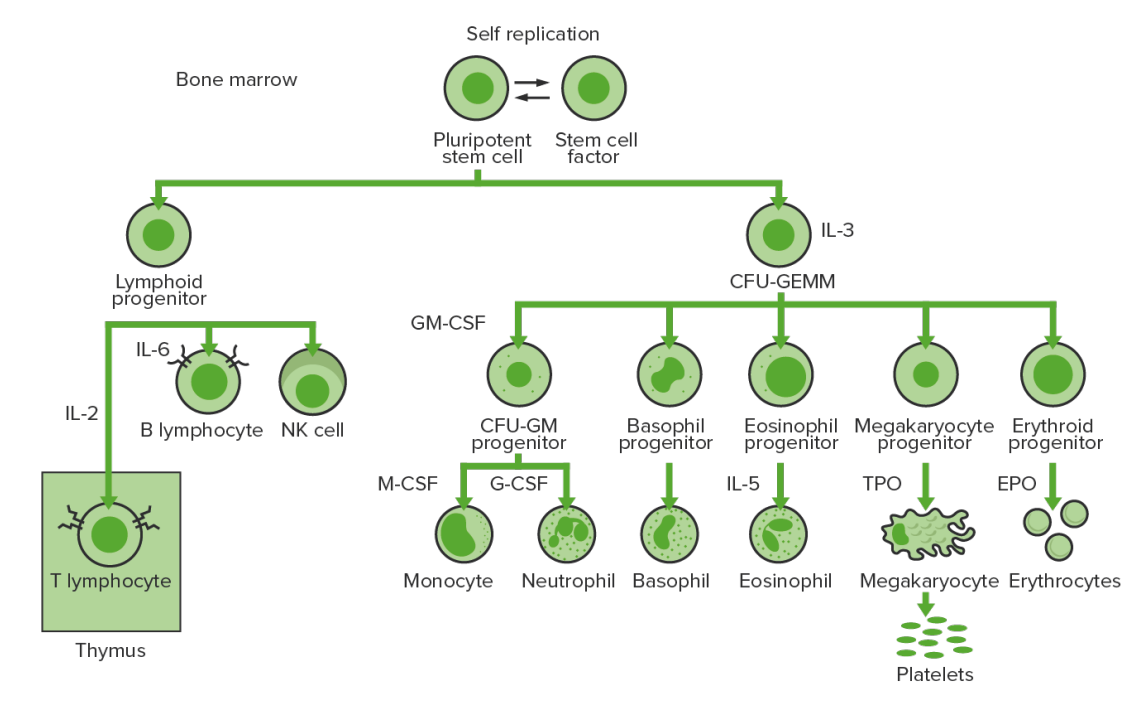Playlist
Show Playlist
Hide Playlist
Blood Cells – Blood Formation
-
Slides Anatomy of the blood.pdf
-
Download Lecture Overview
00:01 Now, blood is a complex mixture of cells but there are three major types that I want to focus on at this stage. 00:08 Red cells, their primary role is to carry oxygen around the body and they are thousand times more numerous than other cells. 00:17 White cells, their major function is to fight infection. 00:22 There are two major subtypes, lymphocytes and myeloid cells. 00:28 And thirdly, platelets, these are small fragments of a megakaryocyte cell and they form blood clots. 00:38 Let's look at red cells in a little more detail and you can see on the right an electron micrograph of red cells showing their biconcave shape -- beautiful picture. 00:48 As we've heard, these are much more common than white cells in the blood. 00:53 And as you will see they don't have a nucleus when they are generated in the bone marrow, the precursor cells exclude the nucleus and the red cells are released into the circulation without a nucleus. 01:07 That limits their survival and they only live around 120 days, a fact beloved of many medical students, for reasons that I've never quite understood but there's something very memorable about that. 01:20 The major purpose of red cells is to carry oxygen deep into our tissues. 01:25 In fact, the vascular system may well have evolved to provide oxygenation deep into tissues. 01:33 And if you'll see, their shape, they're very flexible and that allows red cells to migrate through capillaries, in very small areas and in deep into tissues. 01:44 Let me introduce the first type of white cell, the lymphocyte, and you'll immediately see the very large nuclei to cytoplasmic ratio and the dark staining of the nucleus. 01:58 You'll also see some red cells and small platelets. 02:02 Now lymphocytes are the cells that mediate the function of the immune system particularly the adaptive immune system that makes antibodies and also can kill virally infected cells. 02:15 They are very sophisticated cells and they can live for many years and they constantly circulate between the blood and through lymphoid tissues searching for pathogens and to initiate immune responses. 02:30 There are two major types of lymphocytes, the T cell and the B cell, and they have slightly different functions. 02:39 Neutrophils are the other major subset of white cell. 02:44 They have a critical role in fighting bacteria and fungal infection and when we have patients in hospital wards who are having chemotherapy, we often suppress by this treatment our neutrophil count and that can leave patient very prone to infections. 03:01 You'll see on the right some of these neutrophils and you'll see immediately how the nucleus is very characteristic, multilobed and they contain a number of granules. 03:14 As we'll see, they are released from the bone marrow and survive around two or three days before entering tissues. 03:24 They can ingest bacteria and cells which had become covered with antibody acting as a signal for the ingestion and destruction of that cell. 03:36 Once they've taken in bacteria and opsonized cells, is these cells with antibody are called, they can then kill them, using toxic enzymes and oxygen radicals. 03:48 Monocytes, are also an important subset of white cells, you'll see one there slightly larger than the lymphocyte, of cytoplasm and lobed nucleus. 04:00 These cells migrate into many tissues where they become macrophages, the reticuloendothelial system. 04:10 They also play an important role in the ingestion of bacteria. 04:15 They also have a very useful and important role in triggering immune responses particularly making that link between innate or early immune responses driven by neutrophils and monocytes and the adaptive immune response where T cells and B cells can start to generate specific antibody and specific cellular defenses against pathogens. 04:42 Finally, platelets, the third major subset of cells within the body or within the blood. 04:48 These are fragments of cytoplasm which bud off megakaryocytes in the bone marrow. 04:56 You can see on the top right, the blood film there, the little purple fragments there are platelets -- much smaller than the red cells. 05:06 Within the bone marrow the megakaryocyte extrudes its cytoplasm into the blood stream and it can release 1 or 5000 platelets from each megakaryocyte into the blood. 05:19 And you'll just see on the bottom -- these are very sticky cells and they stick to areas of damage within the blood vascular system and they trigger the formation of a blood clot. 05:31 If patients are deficient in platelets or have deficient platelet function, they can get bleeding disorders -- bruising and bleeding.
About the Lecture
The lecture Blood Cells – Blood Formation by Paul Moss, PhD, OBE, FMed, FRCPath is from the course Hematology: Basics.
Included Quiz Questions
Which of the following cells remain in the circulation for 120 days?
- Red cells
- Neutrophils
- Platelets
- Monocytes
- Eosinophils
Which cells do the monocytes become when they enter tissue?
- Macrophages
- NK cells
- Dendritic cells
- Plasma cells
- Ganglion cells
Which of the following cells are only cytoplasmic fragments and do not contain nuclei?
- Platelets
- Eosinophils
- RBCs
- Plasma cells
- Monocytes
Which of the following cells develop granules containing toxic enzymes in their cytoplasm?
- Neutrophils
- Eosinophils
- Lymphocytes
- Platelets
- Monocytes
Customer reviews
5,0 of 5 stars
| 5 Stars |
|
5 |
| 4 Stars |
|
0 |
| 3 Stars |
|
0 |
| 2 Stars |
|
0 |
| 1 Star |
|
0 |




